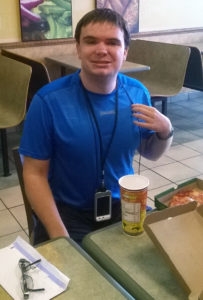When looking toward the future, most parents hope their children will be happy, healthy, and enjoy a satisfying quality of life. For families with a child with autism, this desire is no different. The Autism Society of America identified nine key indicators to consider for assessing and improving the quality of life for individuals with autism: school inclusion, friendships and social connections, health and well-being, academic success, autonomy, independent living, independent employment, subjective well-being, and recreation and leisure (Repella, 2012). When considering many of these indicators, success is dependent upon being successful in community settings.

To be successful in the community, individuals with autism often require more than simple exposure or skill modeling. Simulated learning experiences often have equally limited results in achieving skill generalization in community environments (McDonnell, 2009). To maximize successful community outcomes, it is vital that instruction be delivered in naturally occurring settings. The following outlines the essential components of community-based instruction (CBI) and provides a case study that demonstrates the value of CBI in improving the quality of life for individuals with autism.
Community-Based Instruction Essential Elements
CBI describes skills training in natural settings that enhances learning and facilitates generalization (e.g., Walker, Uphold, Richter, & Test, 2010). More than class field trips, CBI is systematic instruction on specific skills in community environments where the skills are naturally used (Florida Department of Education Bureau of Exceptional Education and Student Services, 2018). CBI can be used to teach skills across a wide range of domains: community (e.g., travel, safety, shopping, accessing services), recreation/leisure (e.g., participating in organized sports, going to the movies), social (e.g., initiating conversations, using manners), communication (e.g., asking for help, ordering food), and employment (e.g., volunteer and work experiences) (Florida Department of Education Bureau of Exceptional Education and Student Services, 2018; Walker et al., 2010). In order to optimize the outcomes of community-based instruction, teams should:
Start early – Some individuals with autism may need several years to master the skills needed to successfully navigate specific settings and generalize the skills to similar but different settings (e.g., Subway versus McDonald’s). Starting during the preschool years is ideal for many students with autism.
Partner with families – Staff should meet with the student and the family to gain information about present skills, behavioral challenges, and goals. It is important to identify community settings where the family frequents, as well as environments where the family may want to visit but is currently unable.
Assess and target specific skills – Identify pivotal skills that the individual needs to achieve greater independence at home and in the community using a structured assessment like the Syracuse Community-Referenced Curriculum Guide (Ford, Schnorr, Meyer, Davern, Black, & Demsey, 2010). Once a skill is identified, the team can create a task analysis which breaks the activity down into smaller, observable steps (McDonnell, 2009).
Collect data – Conduct a baseline probe of the individual’s performance on the task analysis noting the types of prompts needed for each step. Gather data during each community-based instruction session in order to determine progress and make data-based decisions (e.g., determination of skill mastery and when it is time to teach more advanced skills) (McDonnell, 2009).
Use applied behavior analysis (ABA) to teach skills – Develop instructional procedures based on ABA to teach the skills (e.g., chaining strategy, prompting and fading strategies, contingent reinforcement, error correction strategies) (McDonnell, 2009). The use of visual supports (e.g., reminders, prompts, mini-schedules) can also enhance instruction.
Shift the focus of CBI as an individual grows older – CBI evolves to meet the demands of new environments that require increasingly advanced skills. For example, using CBI to teach an individual how to use public transportation looks very different across development. In elementary school, the focus will be on learning how to ride a bus with a teacher or caregiver (e.g., how to choose a seat, how to get on/off the bus). Skill acquisition may evolve to purchasing bus passes, mapping routes, and developing plans to visit new locations. In adulthood, these combined skills will pave the way for greater comfort and confidence in using transportation options that foster community engagement (e.g., work/school, club/activity, friend’s house). The amount of time that each individual spends in community-based instruction will typically increase, especially in middle and high school. By 16 years old, most individuals should spend some time in the community for CBI and community-based employment training each day.
Utilize other resources – Resources are available to assist teams in creating their own CBI programs and to plan for logistical considerations like staffing ratios, transportation, and liability (Florida Department of Education Bureau of Exceptional Education and Student Services, 2018; McDonnell, 2009).
CBI Through the Years: A Case Study
At age 5 years, “Mark” joined in his first CBI outing with classmates to a McDonald’s fast food restaurant. During these first visits, one staff ordered food while two staff members instructed students on selecting a seat and waiting patiently for their meals. Mark and his classmates repeated trips to McDonald’s, each time adding another step to the beginning of the routine (using a backward chaining instructional process) until they were able to order and pay for their own food, take the food to the table, eat the meal, and safely exit the building and board the bus. Mark and his classmates practiced at McDonald’s for some time before generalizing purchasing and waiting skills to other fast food restaurants as well as to grocery stores, the mall, and convenience stores. The students also went on leisure outings to places like bowling alleys and on hikes. By the end of that school year, Mark and his classmates were going into the community to practice skills 2-3 times per week.

Mark enjoying a CBI outing at Subway
As Mark got older, CBI targeted advanced skills to prepare for his transition to adulthood. Mark built employment skills by working at a retirement home and practicing the tasks of setting tables for meals, inputting computer data, and making copies. He also completed filing at two other centers, as well as at his school, where it was discovered that Mark was particularly skilled at tedious detail work that would challenge others. CBI efforts were also geared toward increasing Mark’s participation in leisure and recreational skills (e.g., going to the gym, arcade, miniature golf, etc.). As Mark approached graduation, he found work at a retirement home that was in the community closer to his home. Mark and his team worked diligently on generalizing all of his skills to other settings to ensure a successful transition to adulthood. Mark’s programming has shifted to be almost entirely CBI. He is currently working on expanding his employment skills and enhancing meaningful relationships in the community.
Recognized both in research and anecdotally, the effective implementation of CBI results in enhancing an individual’s skills across community settings and, thus, improving that individual’s quality of life throughout the life span. The challenge our field faces is identifying effective and efficient ways to increase the use of CBI for students across public and private school settings.
Kara Constantine, Ph.D., is a Psychologist at Devereux CAAPP. Todd Harris, Ph.D. is Executive Director of Autism Services and the National Autism Consultant of Devereux. Cathleen Albertson Deutsch, M.A., BCBA, is a Clinical Coordinator at Devereux CARES. Amanda Duffy, M.Ed., BCBA, LBS, is Program Director at Devereux CAAPP. Lucas Cepeda, M.S., BCBA, is a Clinical Coordinator at Devereux CARES.
For any additional information about the content of this article, please feel free to contact Dr. Kara Constantine at kconsta2@devereux.org or 610-688-4981 or visit devereux.org.
References
Florida Department of Education Bureau of Exceptional Education and Student Services. (2018). Community-based instruction: An instructional strategy [PDF file]. Retrieved from http://project10.info/Documents/CBI_Guide_updated_12.5.18.pdf
Ford, A., Schnorr, R., Meyer, L., Davern, L., Black, J., & Dempsey, P. (2010). The Syracuse community-referenced curriculum guide. Baltimore, MD: Paul H. Brookes Publishing Co.
McDonnell, J. (2009). Instruction in community settings. In J. McDonnell & M.L. Hardman (eds.), Successful transition programs: Pathways for students with intellectual and developmental disabilities (pp. 173-199). Thousand Oaks, CA: Sage Publications.
Repella, J (2012, August 28). Quality of Life Indicators [Webinar]. Presented by the Autism Society of America.
Walker, A.R., Uphold, N.M., Richter, S., & Test, D.W. (2010). Review of the literature on community-based instruction across grade levels. Education and Training in Autism and Developmental Disabilities, 45(2), 242-267.





I found this to be a very informative and interesting article. It is great to see these individuals with Autism finding a great job after experiencing a CBI.